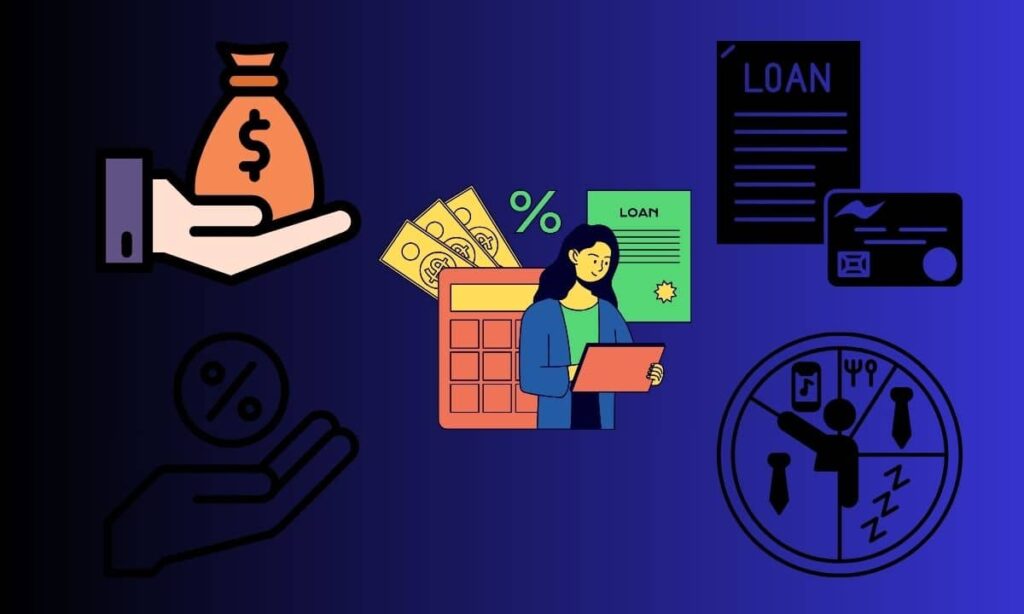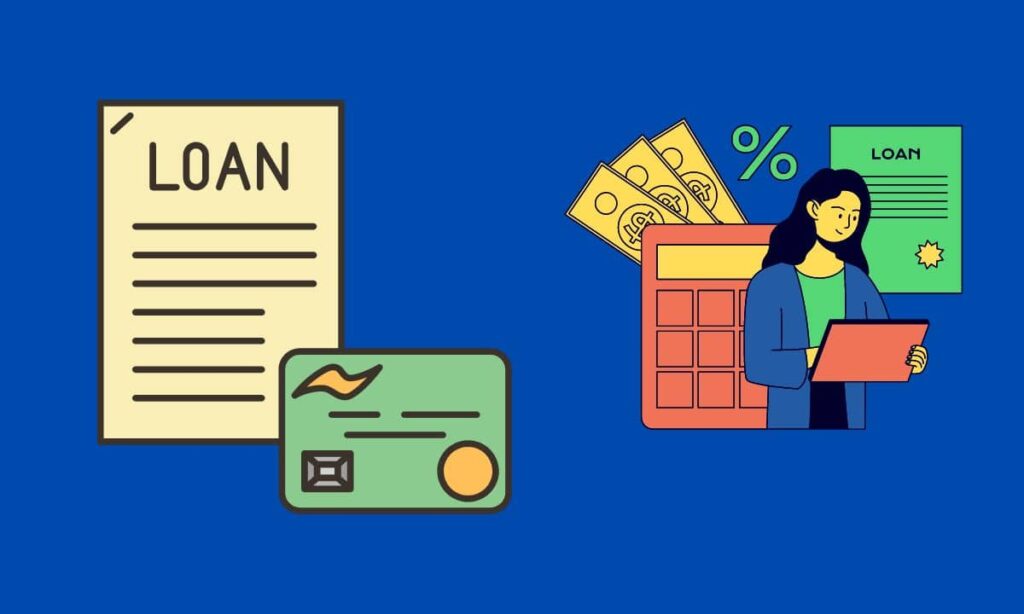Loans can seem like a real headache, right? So many types, and so many details, and just one mistake could land you in a mess of debt. It’s like being stuck in the middle of a vast, confusing jungle with no guide to lead the way.
But imagine if you had a map. A clear guide showing you the right paths to take and the ones to avoid. Imagine knowing the best loan tips and tricks to handle loans with confidence.
Guess what? You’re about to have that in your hands! We’ve put together a comprehensive guide with 32 crucial tips about loans.
From understanding different types of loans to keeping your credit score healthy and ways to prevent loan scams, we want to ensure you’re well-prepared before diving into the world of loans.
By the end of this guide, you’ll feel ready to apply for and manage loans with ease, whether it’s through traditional banks or innovative student loan apps in India. So, let’s get started and turn you into a confident borrower!

Understand the Basics For Loan Tips
1. Types of Loans
There are different loans available in India, each suited for specific purposes. Personal loans can be used for a variety of needs, such as vacations or emergencies. Home loans help you purchase or build a house.
Education loans support students pursuing higher studies. Auto loans enable you to buy a new or used vehicle. Choosing the right loan for your situation is essential for managing your finances effectively.
2. Secured and Unsecured Loans
Loans in India can be broadly categorized into two types – Secured and Unsecured. Here’s a simple breakdown of what they represent, along with a few examples:
a. Secured Loans:
These loans require collateral, an asset you pledge to the bank in case you fail to pay back the loan. For example:
Home Loans: Used to buy or construct a house. The house itself typically serves as collateral.
Auto Loans: Taken out to purchase a vehicle. Typically, the automobile you buy becomes the collateral.
b. Unsecured Loans:
These loans don’t require collateral but usually have higher interest rates due to the increased risk for the lender. For example:
Personal Loans: These can be used for a variety of needs including vacations, home repairs, or emergencies. No collateral is needed.
Education Loans: Given to students for higher education. Usually, no collateral is required unless the loan amount is high.
3. Loan Eligibility
Before approving a loan, lenders usually check a few key things. They look at your income to see if you can afford to repay the loan. Your credit score(CIBIL Score) also matters because it shows how well you’ve handled debt in the past.
Additionally, they’ll check your employment status which can be very important for getting loans in India. Always keep these factors in mind when applying for a loan.
4. Credit History and CIBIL Score
A CIBIL score is a three-digit number that represents your creditworthiness based on your credit history. Lenders use it to evaluate the risk of lending money to you.
A high CIBIL score indicates that you’ve handled your debts responsibly, which can make it easier for you to get approved for new loans or get lower interest rates. Aim to keep the score above 700+ at all times for better Credit access.
5. Impact of EMI on Budget
Paying an Equated Monthly Installment (EMI) regularly affects your monthly budget. It’s a fixed expense you must manage alongside food, rent, and other necessities. If the EMI is high, it leaves less room for savings or other expenses. Therefore, it’s very important to choose a loan with an EMI that suits your budget to maintain financial stability.
Before Applying for a Loan

6. Understanding your Financial Needs
Taking a loan should not always be your first choice. Start by evaluating your financial situation and needs. Consider if you can save for the goal, or cut unnecessary expenses to facilitate it.
Loans can be useful for many of your needs, but remember the additional burden of interest and repayments. Always weigh all options before deciding on a loan.
7. Analyzing Repayment Capability
Analyzing your repayment capability means checking if you can afford to repay a loan. This involves reviewing your income, expenses, and financial obligations. You must ensure that after meeting all your needs, you still have enough funds left to comfortably repay your loan.
8. Fixed vs. Floating Interest Rates
Fixed interest rates remain the same throughout the loan term, making budgeting straightforward. Floating interest rates change with market fluctuations, potentially lowering costs when rates drop, but also increasing risks if rates climb. Choose fixed for predictability or floating if you expect rates to fall.

9. Improving Credit Score
To improve your credit score before applying for a loan, follow these tips:
Timely Bill Payments: Always pay your bills (credit card, utilities) on time to maintain a good payment history.
Credit Utilization: Keep your credit usage below 30% of your total limit to show responsible borrowing behaviour.
Retain Old Accounts: Maintain older credit accounts to showcase a stable credit history.
Limit Loan Applications: Avoid applying for multiple loans or credit cards simultaneously, as it can negatively impact your score.
10. Loan Shopping
Loan shopping is vital as interest rates vary across different lenders. Exploring rates helps you find the most preferable loan terms, potentially saving you a significant amount over the loan’s tenure. A lower rate could mean smaller EMIs or a shorter repayment period. Always compare before making your choice and let’s make our mothers proud.
11. Terms & Conditions
Reading the fine print in a loan agreement (I know you don’t want to but it) helps in identifying the crucial details that could impact your financial health and save you from surprises.
Understand interest rates, penalty fees, and the implications of defaulting on payments and saving you future stress. For clarity on financial terms and jargon, consider using AI tools like ChatGPT to explain complex language and assist you in making an informed decision.
The Loan Application Process

12. Documentation
Properly maintaining complete and correct documentation is core to obtaining a loan smoothly. It helps banks verify your identity, income, and creditworthiness.
Inconsistent or inaccurate information can lead to loan rejection or delays. Thus, double-check all details before submission to ensure an efficient, hassle-free loan approval process. This reminds me of the times my father told me to maintain proper documents for everything and I was like why? Now, I understand why.
13. Purpose/Type of Loan
The purpose of the loan significantly affects the application process. Lenders tailor loan products (e.g., home loans, personal loans, education loans) to fit specific needs, each with unique criteria, interest rates, and repayment terms.
Accurately stating your loan’s purpose helps in selecting the right product and increases the chance of approval.
14. Loan Tenor
Choose the best loan tenor based on your financial situation and preferences. Keep EMIs affordable, consider interest rates, ensure income stability, check prepayment rules, and account for age and retirement. Striking the right balance means easier repayment and reduced loan costs.
15. Guarantors and Co-Applicants

A co-applicant for a loan is someone who applies for the loan with you and shares repaying responsibility. If you can’t repay, they must.
A guarantor, meanwhile, assures the lender they’ll repay the loan if you cannot. They step in only when you default on the loan. Both help get loan approval but have different levels of commitment.
16. Processing Time
Loan approval times can vary widely depending on the lender and type of loan. Personal loans might get approved within 24 hours whereas home loans can take 14-30 days.
Always remember, that these are approximate timelines and delays can occur. It’s best to check with your specific lender for the most accurate timeframe.
17. Multiple Applications
Applying for multiple loans at once can temporarily lower your credit score as each application triggers a hard inquiry into your credit report.
Besides, lenders may view this as high-risk behaviour, reflecting financial distress. It’s better to apply for one loan at a time and only if necessary, keeping your financial health intact.
Post Loan-Approval
18. Repayment Discipline
Repayment discipline is crucial for maintaining a healthy credit score and avoiding extra charges. Timely repayments reflect your reliability as a borrower to lenders and can improve terms on future loans.
Additionally, it helps you avoid late fees, higher interest, and the stress of debt accumulation. Always prioritize your loan repayments for financial stability.
19. Impact of Missing EMI Payments
Missing EMI payments can have severe consequences on your financial health:

-
- Credit Score: Your credit score may drop, as it indicates your inability to manage debt responsibly. This makes it harder to secure loans or credit cards in the future.
-
- Late Fees: Lenders can charge late fees, increasing your overall debt.
-
- Extra Interest: Your interest burden may rise due to delays in principal reduction.
-
- Legal Consequences: Lenders might take legal action if several EMI payments are missed, possibly leading to loan default.
-
- Collateral Seizure: For secured loans, lenders have the right to seize collateral if continuous defaults occur.
20. Income Management and Budgeting
Managing loans effectively involves planning and budgeting. Prioritize your loans based on the highest interest rate.

Consolidate loans if possible to simplify repayment. Create a monthly budget to separate your needs from your wants, ensuring timely loan repayment. Regular check-ins on your progress will ensure you stay on track.
21. Early Repayment
Early repayment of loans has several advantages. Firstly, it reduces the total interest you pay, saving money. Secondly, it improves your credit score by clearing debt quickly. Lastly, it offers a sense of financial freedom by removing the burden of debt, thus reducing stress.
22. Understanding Loan Statements
Understanding your loan statement is crucial for managing debt. It includes details like the principal amount, the rate of interest, and the tenure of the loan. Look at the ‘outstanding amount’ to know what is left to be paid. Check the ‘payment due date’ to avoid penalties(who wants to pay extra ?). Always ensure the ‘interest and principal’ breakup is well understood for effective repayment planning.
23. Rights of a Borrower
Borrowers in India are protected under regulatory frameworks like RBI guidelines. They have the right to transparent loan terms, including interest rates and repayment schedules. Borrowers can question hidden charges and raise grievances against unfair practices. They also have the right to prepay or foreclose a loan with minimal charges, as per the Fair Practices Code.
24. Loan Balance Transfers
A loan balance transfer refers to transferring your existing loan from one lender to another offering lower interest rates or better services. It can be beneficial, as it helps borrowers save on total interest payments, enjoy better service or loan terms, and even consolidate multiple loans to one for easier management.
Dealing with Loan Challenges and Options
25. Top-Up Loans
Top-up loans let you borrow more money atop an existing loan. The pros include access to extra funds without a new credit check and potentially lower interest rates than separate loans.
However, cons include a longer debt period, increased total interest, and the risk of over-borrowing, which can strain your finances.
26. Debt Consolidation
Debt consolidation simplifies multiple loan payments by combining them into a single payment, often with a lower interest rate. This convenience can reduce financial stress and help manage debt better.
However, the major consideration is that this could extend repayment time and the total interest paid might be higher.
27. Loan Moratorium

A loan moratorium offers a temporary break on loan repayments during financial difficulties. When and how to apply varies by lender, but typically needs a valid reason and timely application.
Despite immediate relief, remember interest often still accumulates, potentially increasing the overall payment amount the longer the moratorium lasts. You may have heard this term in the context of RBI providing Moratorium period to Banks.
28. Loan Restructuring
Loan restructuring offers altered loan terms, like lower monthly payments or extended repayment time, during financial hardships. It’s essential when keeping up with payments becomes challenging.
To renegotiate, you should contact your lender, explain the situation, and propose new terms. But remember, this can lead to more interest over time.
29. Debt Traps
‘Debt traps’ are situations where too much borrowing can create a big financial problem. These problems can happen when:
-
- The amount of money you have to pay back each month is too high.
-
- The loan details are not clear.
-
- You borrow money for things you don’t really need.
Here’s how to avoid falling into a debt trap:
-
- Keep track of your money. Make sure you have enough for your needs before you think about borrowing.
-
- Only borrow from trustworthy loan companies.
-
- Always try to pay off existing loans before considering taking out more.
30. Risks of Being a Guarantor

Being a guarantor means promising to pay someone else’s loan if they can’t. It’s a big responsibility and carries risks:
-
- Financial Responsibility: If the borrower can’t pay, you’re on the hook for the debt.
-
- Impact on Credit Score: The borrower’s missed payments can hurt your credit too.
-
- Limited Borrowing Capacity: Being a guarantor can affect your ability to get loans, as lenders consider the guaranteed loan as your potential debt.
-
- Relationship Strain: If issues arise with repaying the loan, it can strain or damage your relationship with the borrower.
Always think carefully before agreeing to be a guarantor, and consider the borrower’s reliability and your ability to cover the debt if needed.
31. Beware of Fraud
Some people trick others by promising easy loans. They ask for money or your personal information first, but it’s a scam. To stay safe, don’t trust offers that seem too good. Always look into who you’re dealing with, never pay upfront, and keep your personal details secure.
32. Loan Insurance
Loan insurance helps you when you can’t pay a loan due to reasons like job loss or illness. It makes sure your loan gets paid. Insurance usually covers parts or all of your loan payments when you face trouble. Remember, the benefits vary based on the policy you choose.

Conclusion
In essence, borrowing is an essential tool of present-day life, driving our aspirations and dreams to reality. Whether it’s stepping into your dream house, ensuring a top-notch education for your children, or owning that longed-for car, loans make these goals achievable. But like all tools, loans come with responsibility. Understanding your financial needs, capabilities, and the loan landscape is imperative. Remember the golden rule – Borrow Responsely!
What’s your best piece of advice when it comes to managing loans? We’d love to hear about your journey and any tips you’d like to share with fellow readers. Remember, sharing is caring! If you found this article beneficial, don’t forget to pass it along to friends and family pondering over loan decisions.
Frequently Asked Questions (FAQs)
What are the key factors that determine my eligibility for a loan?
How can I decide between a fixed-rate and a floating-rate loan?
Floating-rate loans, however, may start with a lower rate and adjust over time, potentially saving money if interest rates decrease but also bearing the risk of increasing rates.



4 Comments